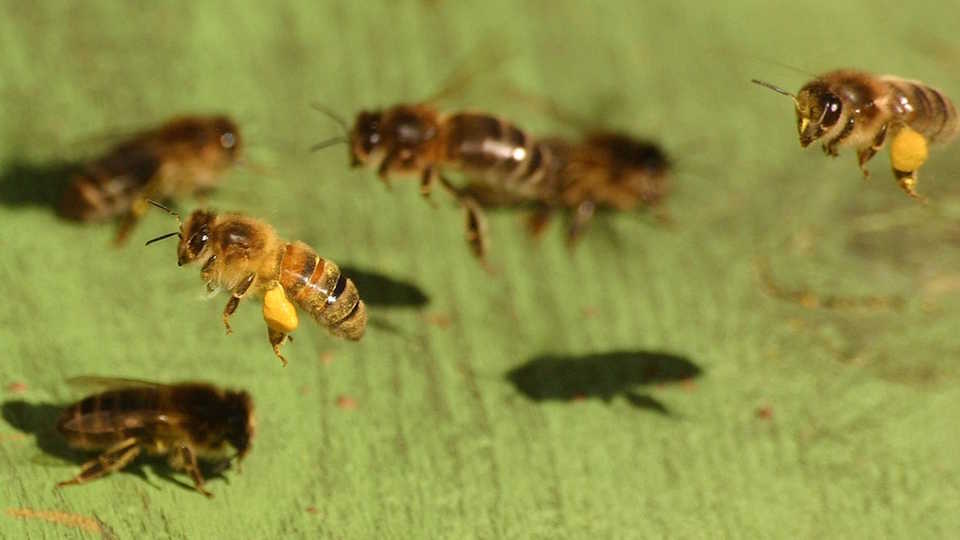Science News
Honeybee Help

Honeybees continue to die in catastrophic numbers. Colony collapse disorder (CCD), as the phenomenon is called, has only worsened since its discovery in 2006, with beekeepers reporting a 42% loss in their colonies last year. And remember, this isn’t just about the bees: in May 2013, the USDA reported that one in three bites of food depends on pollination, mainly by honeybees, and that pollination is valued at $20 to $30 billion annually.
So scientists, farmers, and policy-makers are scrambling to find help for the struggling insects. To that end, two studies were published last week on the two leading causes of honeybee decline—the Varroa mite and the type of pesticide called neonicotinoids.
Researchers used museum collections to determine how a population of wild bees from upstate New York survived an infestation of the Varroa mite. These mites attach themselves to the bees and vampirically suck their hemolymph (i.e., insect blood). This leaves the bees weak and susceptible to disease, devastating entire colonies. The mite infestation occurred among the New York bee colonies in the mid-1990s. “They took a hit, but they recovered,” says Alexander Mikheyev, of the Okinawa Institute of Science and Technology Graduate University (OIST) and lead author of the study, published in Nature Communications. “The population appears to have developed genetic resistance.”
The team found significant differences in the mitochondrial DNA of specimens of wild bees collected in 1977 versus those collected in 2010, as well as in various genes, such as those related to development. Because mitochondrial DNA is only passed on from the mothers, a major change indicates that the queen bees were wiped out and that there were large-scale population losses. Even so, the population maintained a high level of genetic diversity throughout the rest of genome. Genetic diversity is the raw material for evolution, and high genetic diversity increases the chance for successful adaptation.
One of the most interesting changes in the bee population occurred in a gene related to a dopamine receptor known to control aversion learning. Another study has suggested that this receptor is involved with bees eliminating the mites by chewing them up. Also, there were physical changes—today’s bees are smaller than the older bees and their wing shapes differ.
“These findings identify candidate genes that could be used for breeding more resistant bees, such as the dopamine receptor gene,” Mikheyev says. “More importantly, it suggests the importance of maintaining high levels of genetic diversity in domestic bee stocks, which may help overcome future diseases.”
Although the European Union has banned pesticides containing neonicotinoids in response to evidence suggesting that these chemicals contribute to bee decline, they remain legal in the U.S., with debates continuing over the true contribution of “neonics” (as they’re called) to CCD. Yet a very cautious study, published last week in Scientific Reports, found a correlation between the increased use of neonics on rapeseed and escalating honeybee losses over an 11-year period across England and Wales.
The researchers looked at data sets on pesticide use, land use, rapeseed yield, meteorological conditions, and honeybee colony losses in the region from 2000 to 2010. They found that whereas increased neonic seed coatings hurt the bees, the increase also reduced the number of subsequent pesticide applications. However, it didn’t have an overall effect on crop yield.
Lead author Giles Budge says, “Our analyses suggest that honeybee colonies are being lost due to a range of pressures including imidacloprid [pesticides that contain neonics] usage, regional factors, adverse weather and, in our other work, pests and diseases. The drivers behind these losses are complex but it is important that the science community continue to present a balanced argument to help farmers, beekeepers and the public understand the costs and benefits of agricultural practices. Further evidence, particularly from large scale field studies, is vital.”
It could be argued that the ban on neonics while further studies are done is vital, too. If there are no economic benefits either way, according to this study, it seems that a pause in using neonics will not hurt farmers—and could help the bees tremendously.